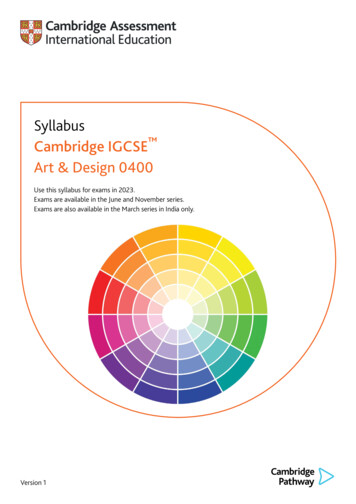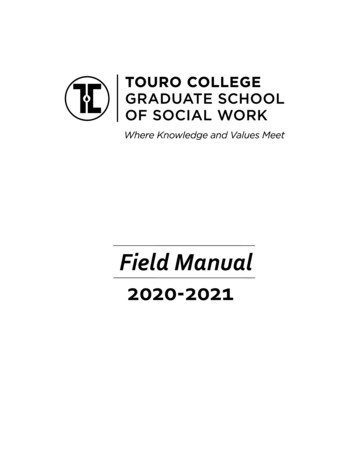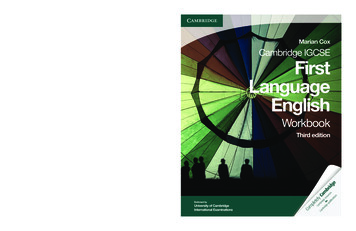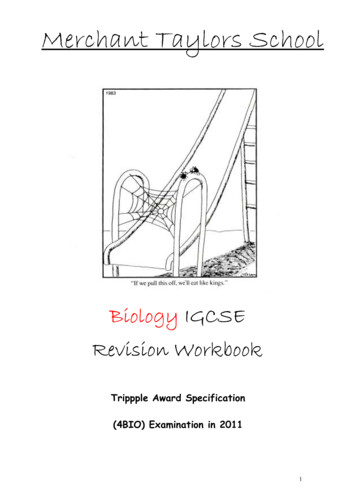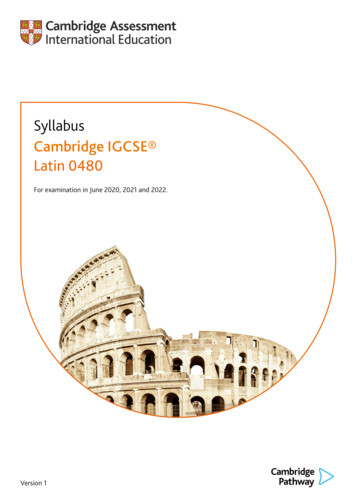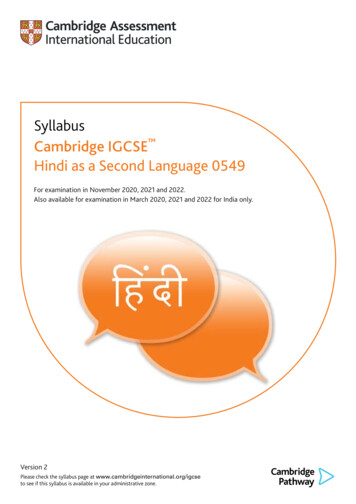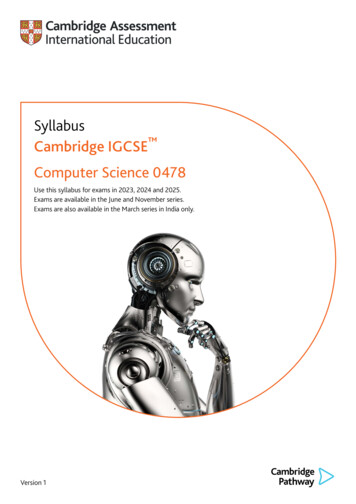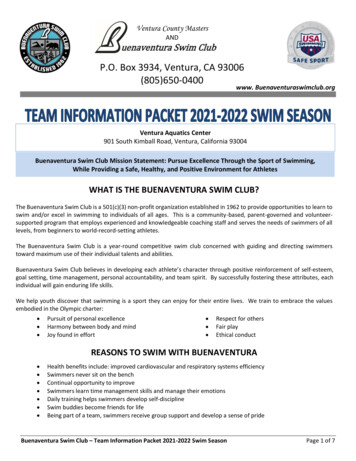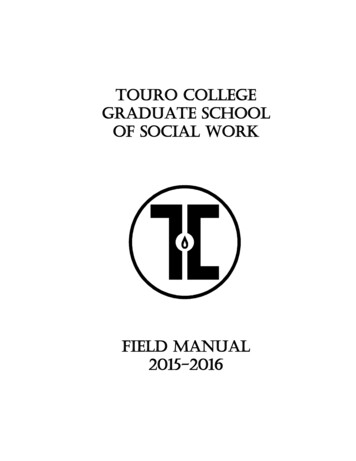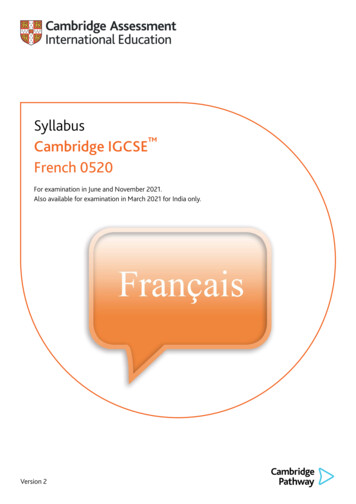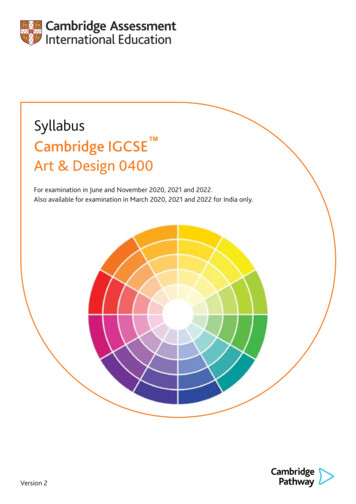
Transcription
SyllabusCambridge IGCSE Art & Design 0400For examination in June and November 2020, 2021 and 2022.Also available for examination in March 2020, 2021 and 2022 for India only.Version 2
Why choose Cambridge?Cambridge Assessment International Education prepares school students for life, helping them develop an informedcuriosity and a lasting passion for learning. We are part of the University of Cambridge.Our international qualifications are recognised by the world’s best universities and employers, giving students awide range of options in their education and career. As a not-for-profit organisation, we devote our resources todelivering high-quality educational programmes that can unlock learners’ potential.Our programmes and qualifications set the global standard for international education. They are created by subjectexperts, rooted in academic rigour and reflect the latest educational research. They provide a strong platform forlearners to progress from one stage to the next, and are well supported by teaching and learning resources.Our mission is to provide educational benefit through provision of international programmes and qualifications forschool education and to be the world leader in this field. Together with schools, we develop Cambridge learnerswho are confident, responsible, reflective, innovative and engaged – equipped for success in the modern world.Every year, nearly a million Cambridge students from 10 000 schools in 160 countries prepare for their future withan international education from Cambridge International.‘We think the Cambridge curriculum is superb preparation for university.’Christoph Guttentag, Dean of Undergraduate Admissions, Duke University, USAQuality managementOur systems for managing the provision of international qualifications and education programmesfor students aged 5 to 19 are certified as meeting the internationally recognised standard forquality management, ISO 9001:2008. Learn more at www.cambridgeinternational.org/ISO9001Cambridge Assessment International Education is part of the Cambridge Assessment Group. Cambridge Assessment is the brand name ofthe University of Cambridge Local Examinations Syndicate (UCLES), which itself is a department of the University of Cambridge.UCLES retains the copyright on all its publications. Registered centres are permitted to copy material from this booklet for their owninternal use. However, we cannot give permission to centres to photocopy any material that is acknowledged to a third party even forinternal use within a centre.
Contents1 Why choose this syllabus? . 22 Syllabus overview .4Aims4Content overview5Assessment overview5Assessment objectives63 Subject content . 7Painting and related media7Print making8Three-dimensional design9Photography, digital and lens-based media10Graphic communication11Textiles and fashion124 Details of the assessment .13Component 1 Coursework13Component 2 Externally Set Assignment14Avoidance of plagiarism15Assessment criteria for Component 1 and Component 2165 What else you need to know . 17Before you start17Making entries18After the exam19How students and teachers can use the grades19Grade descriptions19Changes to this syllabus for 2020, 2021 and 202220Changes to this syllabusFor information about changes to this syllabus for 2020, 2021 and 2022, go to page 20.The latest syllabus is version 2, published April 2019.
Cambridge IGCSE Art & Design 0400 syllabus for 2020, 2021 and 2022.1 Why choose this syllabus?Key benefitsCambridge IGCSE syllabuses are created especially for international students. For over 25 years, we have workedwith schools and teachers worldwide to develop syllabuses that are suitable for different countries, different typesof schools and for learners with a wide range of abilities.Cambridge IGCSE Art & Design encourages a range of skills, stimulates aesthetic awareness, knowledge and criticalunderstanding of art, and provides opportunities for learners to develop a range of skills. Crucially, a personal andindependent perspective is encouraged at all times. The syllabus is designed to accommodate a wide range ofabilities, materials and resources, and allows the different skills of the teaching staff to be fully used.The syllabus appeals to learners who wish to explore practical work through a range of two- and/orthree-dimensional processes and include new media and technologies in addition to traditional media andprocesses.The syllabus helps equip learners with lifelong skills including: confidence and enthusiasm as they develop technical skills in two- and/or three-dimensional form andcomposition the ability to identify and solve problems in visual and tactile forms the ability to develop ideas from initial attempts to outcomes.Our programmes balance a thorough knowledge and understanding of a subject and help to develop the skillslearners need for their next steps in education or employment.Our approach encourages learners to be:Cambridgelearner‘The strength of Cambridge IGCSE qualifications is internationally recognised and has providedan international pathway for our students to continue their studies around the world.’Gary Tan, Head of Schools and CEO, Raffles International Group of Schools, Indonesia2www.cambridgeinternational.org/igcseBack to contents page
Cambridge IGCSE Art & Design 0400 syllabus for 2020, 2021 and 2022. Why choose this syllabus?Recognition and progressionThe combination of knowledge and skills in Cambridge IGCSE Art & Design gives learners a solid foundation forfurther study. Candidates who achieve grades A* to C are well prepared to follow a wide range of courses includingCambridge International AS & A Level Art & Design.Cambridge IGCSEs are accepted and valued by leading universities and employers around the world as evidence ofacademic achievement. Many universities require a combination of Cambridge International AS & A Levels andCambridge IGCSEs or equivalent to meet their entry requirements.UK NARIC, the national agency in the UK for the recognition and comparison of international qualifications andskills, has carried out an independent benchmarking study of Cambridge IGCSE and found it to be comparable tothe standard of GCSE in the UK. This means students can be confident that their Cambridge IGCSE qualificationsare accepted as equivalent to UK GCSEs by leading universities worldwide.Learn more at ng teachersWe provide a wide range of practical resources, detailed guidance, and innovative training and professionaldevelopment so that you can give your learners the best possible preparation for Cambridge IGCSE.Teaching resourcesExam preparation resources School Support Hubwww.cambridgeinternational.org/support Question papers Syllabus Scheme of work Example candidate responses to understandwhat examiners are looking for at key grades Learner guide Examiner reports to improve future teaching Mark schemes Discussion forum Resource list Endorsed textbooks and digital resourcesTrainingSupport forCambridgeIGCSE Face-to-face workshops around the world Online self-study training Online tutor-led training Cambridge Professional DevelopmentQualificationsCommunityYou can find useful information, as well asshare your ideas and experiences with otherteachers, on our social media channels andcommunity forums.Find out more mbridge IGCSE is one of the most sought-after and recognised qualifications in the world. Itis very popular in Egypt because it provides the perfect preparation for success at advanced levelprogrammes.’Mrs Omnia Kassabgy, Managing Director of British School in Egypt BSEBack to contents pagewww.cambridgeinternational.org/igcse3
Cambridge IGCSE Art & Design 0400 syllabus for 2020, 2021 and 2022.2 Syllabus overviewAimsThe aims describe the purposes of a course based on this syllabus.The aims are to enable students to develop: an ability to record from direct observation and personal experience an ability to identify and solve problems in visual and/or other forms creativity, visual awareness, critical and cultural understanding an imaginative, creative and personal response confidence, enthusiasm and a sense of achievement in the practice of art and design growing independence in the refinement and development of ideas and personal outcomes engagement and experimentation with a range of media, materials and techniques, including new media andtechnologies, where appropriate experience of working in relevant frameworks and exploration of manipulative skills necessary to form,compose and communicate in two and/or three dimensions a working vocabulary relevant to the subject and an interest in, and a critical awareness of, other practitioners,environments and cultures investigative, analytical, experimental, interpretative, practical, technical and expressive skills which aideffective and independent learning.Support for Cambridge IGCSE Art & DesignOur School Support Hub www.cambridgeinternational.org/support provides Cambridge schools with asecure site for downloading specimen and past question papers, mark schemes, grade thresholds and othercurriculum resources specific to this syllabus. The School Support Hub community offers teachers theopportunity to connect with each other and to ask questions related to the syllabus.4www.cambridgeinternational.org/igcseBack to contents page
Cambridge IGCSE Art & Design 0400 syllabus for 2020, 2021 and 2022. Syllabus overviewContent overviewCambridge IGCSE Art & Design has been designed to offer a broad choice of media and approaches so thatcandidates can produce a personal response and schools can play to their strengths in terms of staff expertise andinterests.The broad areas of study are: painting and related media print making three-dimensional design photography, digital and lens-based media graphic communication textiles and fashion.Candidates can respond to either component using any of the media above.Assessment overviewAll candidates take two components.All candidates take:Component 1Courseworkand:50%Component 2Externally Set Assignment8 hours50%100 marks100 marksCandidates research, develop and realise aproject from one area of study in the subjectcontent from a theme set by the teacher.Candidates respond to one starting point setby Cambridge International. Candidates mayproduce work from the same area of study asComponent 1, but they do not have to.There are two parts to the coursework:– a portfolio and– a final outcome.Externally assessedThere are two parts to the assignment:– supporting studies and– a final outcome, produced during asupervised test of 8 hours’ total duration.Externally assessedPlease check the samples database at www.cambridgeinternational.org/samples for submission information anddeadlines for Component 1 Coursework.Please check the timetable at www.cambridgeinternational.org/timetables for the test date window forComponent 2.Back to contents pagewww.cambridgeinternational.org/igcse5
Cambridge IGCSE Art & Design 0400 syllabus for 2020, 2021 and 2022. Syllabus overviewAssessment objectivesThe assessment objectives (AOs) are:AO1 RecordRecord ideas, observations and insights relevant to intentions as workprogressesAO2 ExploreExplore and select appropriate resources, media, materials, techniques andprocessesAO3 DevelopDevelop ideas through investigation, demonstrating critical understandingAO4 PresentPresent a personal and coherent response that realises intentions anddemonstrates an understanding of visual languageWeighting for assessment objectivesThe weightings allocated to each of the assessment objectives (AOs) are summarised below.Assessment objectives as a percentage of the qualificationAssessment objectiveWeighting in IGCSE %AO1 Record25AO2 Explore25AO3 Develop25AO4 Present25Assessment objectives as a percentage of each componentAssessment objective6Weighting in components %Component 1Component 2AO1 Record2525AO2 Explore2525AO3 Develop2525AO4 k to contents page
Cambridge IGCSE Art & Design 0400 syllabus for 2020, 2021 and 2022.3 Subject contentThe areas of study listed below provide a framework of art and design practice and indicate an approach thatencourages exploration. Learners may use either traditional media or new media or a combination of both,providing all assessment objectives are met. Candidates are encouraged to produce a variety of creative responsesthrough exploration with a range of materials, processes and techniques.Candidates are not expected to produce work from all the areas of study. They are, however, expected to: identify and research a particular aspect of art and design carry out relevant exploration of media, materials, techniques and appropriate processes document and evaluate ideas and concepts against intentions as the work progresses develop these into a cohesive final outcome.Painting and related mediaIn response to studies within this area, candidates are expected to demonstrate skills in either a representationalor a descriptive manner, or they may be more imaginative and interpretative. The work should evolve throughinvestigation and development by the candidate. Responses may be based on a directly observed starting point orsubject, or they may be the candidate’s personal response to a theme.Subjects could include: landscapes artefacts figure studies abstract notions or feelings portraits personal experiences the natural or built environment visual ideas inspired by literary sources still-lifeCandidates should learn to use a sketchbook to make visual and/or other appropriate research and develop theirideas. They should also show knowledge of art and design from other cultures or history and relate it to their ownstudies.Painting and drawingCandidates should be encouraged to work from direct observation and to explore the use of tone, colour andcomposition, materials and context. This can be shown through the use of processes and the use of media such ascharcoal, pencil, pastels, acrylic, water colour, oil and inks.Graphic mediaCandidates should be encouraged to demonstrate the communication of visual and/or other meaning throughimages. Candidates should explore an expressive and personal response in their work.Print makingCandidates should be encouraged to explore image-making rather than the specific design for industrial designprocesses, such as repeat fabric design. Ideas and development will evolve through investigation, development andexperience that could be gained from direct observation or a personal response to a theme.Back to contents pagewww.cambridgeinternational.org/igcse7
Cambridge IGCSE Art & Design 0400 syllabus for 2020, 2021 and 2022. Subject contentNon-traditional mediaCandidates should be encouraged to explore using traditional or new media or a combination of both. Candidatescan also produce work for assessment in any two-dimensional form such as collage or textiles. The use of mixedmedia or waste materials for collage is acceptable.New mediaCandidates may wish to explore using installation art, animation, audio or moving image in their work. The designprocess should include research, ideas development, review and creation, and this should be evidenced in thesupporting work. For site-specific works or works using found objects, visual images should be supplied in the mostrelevant format with a clear evaluation of the processes and materials used and the creative intentions of the piece.Print makingThis includes all aspects of print making that relate to image-making rather than specific design for industrialprocesses, such as repeat fabric design. Development of ideas will evolve through investigation and experiencegained from direct observation. Candidates should explore a variety of print making techniques and produce eithera series of related images or one-off prints using methods such as monoprinting, relief printing (such as lino and/orwood cut), etching and screen printing.MonoprintingCandidates should be encouraged to explore a variety of traditional and new media approaches to monoprintingand to work in a range of different materials.Relief printingUsing traditional or new media or a combination of both, candidates should be encouraged to explore a varietyof approaches. Candidates may employ a range of different materials, mixed media or use improvised or wastematerials to create work.EtchingCandidates should be encouraged to explore the use of line, tone, texture and composition when using this process.Traditional and/or new media approaches should be encouraged when using metal or plastic plates.Screen printingCandidates should be encouraged to explore a variety of traditional and/or new media approaches to screenprinting. Using traditional and/or digital processes, candidates should demonstrate an expressive and personalresponse in their work.8www.cambridgeinternational.org/igcseBack to contents page
Cambridge IGCSE Art & Design 0400 syllabus for 2020, 2021 and 2022. Subject contentThree-dimensional designCandidates may work in traditional media and/or new materials or a combination of both, but should show anunderstanding of three-dimensional qualities of volume, form and space appropriate to their chosen specialism.Candidates should create visual and/or other meaning through three-dimensional art by expressing functionaland/or decorative responses. In sculpture, the work may be figurative or abstract; candidates can employtechniques of carving, modelling or construction. There should be some awareness of the roles sculpture has playedin various societies. In ceramics, candidates should study a range of techniques and become familiar with severalmethods of decoration, understand firing and glazing, and have knowledge of the different uses of ceramics. Theyshould be aware of aesthetic considerations and have some historical and cultural knowledge.Candidates should demonstrate an expressive and personal response in their work, appropriate to the task.Supporting work should include designs, notes on materials and processes, etc. Photographs of source material andother work should be included, as should evidence of visits made in connection with the course of study.SculptureCandidates should explore form, space, mass, volume, surface and materials. They should use a range of processes,techniques and materials such as carving and modelling, casting or constructing, plaster and wax.CeramicsCandidates should show an understanding of the processes involved in making, drying, firing, decorating andglazing. Candidates should also show ability in constructional methods such as slab building and coil and handmaking and the application of surface treatments, e.g. slips, oxides and glaze.Theatre design/set designCandidates should demonstrate the use of design for performance through areas such as costume, set design andlighting. Candidates should document their work through photographs or digital layouts, as well as a sketchbook,three-dimensional models and scale drawings.Environmental/architectural designCandidates should demonstrate their understanding through the use of spatial design in an environmental/architectural context in either public or private spaces. Candidates should also be familiar with role, function,location and audience as well as environmental/architectural issues.Product designCandidates should demonstrate how they can problem-solve by designing or creating products that have afunctional or decorative role. Candidates should work with a range of materials such as wood, metal, plastics andglass. Candidates will need to demonstrate how the design process itself results in a variety of possible designsolutions. It is not necessary for candidates to produce full-scale models, but they should be aware of the possibleconstraints that might occur during the manufacturing process. Design software and technology should be exploredwhere available, e.g. three-dimensional digital media and laser cutting.Craft designCandidates should cover a wide range of techniques, skills and materials. Candidates’ work should indicate a cleardesign brief. Candidates should also demonstrate how they can problem-solve by designing and/or creating craftthat has a functional and/or decorative role. This could include jewellery, metalwork (wire), papier mâché, mosaic,puppet-making and local craft.Back to contents pagewww.cambridgeinternational.org/igcse9
Cambridge IGCSE Art & Design 0400 syllabus for 2020, 2021 and 2022. Subject contentPhotography, digital and lens-based mediaCandidates should use traditional and/or new media processes to produce outcomes such as photomontage,printed photography, digital photography, photographic or digital installation, animation, film and digital creationand manipulation. Work may be in colour and/or black and white.Candidates should demonstrate an expressive and/or interpretative artistic response to the visual world. Theyshould show an understanding of the conventions of photography and genres such as portrait, landscape andmovement, and a range of techniques appropriate to their chosen field.Consideration of the following techniques should be given: depth of field, lighting and exposure viewpoint/composition and framing film speed/shutter speed editing and transitionsCandidates should also show skills in experimenting with media and processes, such as: abstracting alternative print processes (liquid emulsions,bleaching, resist, toning, use of specialist papers or illustratingother photosensitive surfaces) documenting creation and manipulation of images with computers developing and printing of films image scanning and manipulation darkroom practice (pin-hole cameras, burning editing, perhaps using soundin, masking, photograms, solarisation, multipleexposure, reversal printing)Photography may be used as a means of recording fragile, large or time-based work (e.g. work in perishable media,installations, mural work and performance) and the photographic record will be considered and assessed as part ofthe submission.Candidates must provide appropriate evidence of the authenticity of their work such as contact prints, thumbnailsof original digital photographs or storyboards.Information on submitting moving image work can be found in the Guide to Administering Art & Design.Candidates may develop their own blogs or video blogs and social networking sites but the authenticity of the workproduced must be evidenced in the supporting work showing the development of ideas. All research must be clearlyreferenced.Still imageryCandidates should demonstrate their skill in the production of still images through a lens-based approach.Candidates will demonstrate an understanding and control of equipment in order to produce work that is personal.Using a wide range of methods, techniques and processes, candidates will produce imagery that is their own work.Candidates may develop their own work using darkroom facilities, if available; however, the use of commerciallyprocessed photographs is acceptable.For candidates using digital and lens-based media, their work should show evidence of the manipulation andpresentation of the imagery using a computer. A variety of approaches and processes can be used together andcandidates could present their work in a variety of ways – either as printed images or electronically as a slide show.Lighting and sound may be used as Back to contents page
Cambridge IGCSE Art & Design 0400 syllabus for 2020, 2021 and 2022. Subject contentMoving imageryCandidates should demonstrate an understanding of the recording and presentation of moving images. Sound mayalso be included as appropriate. Candidates should be familiar with a range of techniques, resources and processes,such as storyboards, animation, digital editing and presentations. Any moving image work should be no longer thanthree minutes.Graphic communicationCandidates should use appropriate methods, materials and techniques as well as presentational skills. All imageryshould be the candidate’s original work, although manipulation of secondary sources through various softwarepackages and digital processes is acceptable, as long as it only represents a proportion of the overall work.Supporting work should show ideas, themes and sources used. Technical processes, including computer-generatedimagery and personal digital media, should be clearly documented. The development of printmaking processesshould be included, as should knowledge of both historical and contemporary graphics.Candidates should demonstrate the communication of visual meaning through images while being mindful ofproblems and opportunities, as well as working towards appropriate solutions. They should analyse design briefsand tackle practical design tasks. They should study other examples of design or the work of designers relevant totheir chosen field, preferably including some work at first hand, and relate this experience to their own endeavours.Graphic design with letteringCandidates should demonstrate their understanding of typography and its relationship to images. Candidates arefree to work in any medium, including photography and computer-manipulated imagery, providing the majority ofimages are from the candidates’ first-hand studies from primary research.IllustrationCandidates should demonstrate how the creation of imagery can enhance and allow different interpretationsof text. Candidates should produce visual imagery that communicates the role and context of text to a specificaudience. The illustrations may be for inclusion in any number of publications such as magazines, books, postersand leaflets, blogs and websites.Print makingCandidates will not be expected to be familiar with all aspects of print making. They will be expected to havedeveloped ideas and these will have evolved through investigation, development and experience gained fromfirst-hand studies from primary sources or a personal response to a chosen theme (see Print making section).AdvertisingCandidates should have an understanding of how graphic communication can sell a product or service, promotebrand images and communicate information through, for example, posters, fliers, logos, corporate identities,symbols or signs. Print media, packaging and web-based outcomes and campaigns should be explored.Game designCandidates should be able to combine drawing and software skills to create concept artwork, environments,gameplay, storyboards or character development related to a theme or brief. Supporting work for digitallyproduced artwork should include evidence of the development of ideas and understanding techniques andprocesses. Prototype platform games and role-playing games (RPG) concepts can be produced, and should haveage-appropriate content.Back to contents pagewww.cambridgeinternational.org/igcse11
Cambridge IGCSE Art & Design 0400 syllabus for 2020, 2021 and 2022. Subject contentTextiles and fashionCandidates should demonstrate an expressive, decorative or functional response through the use of fabrics, dyesand fibres. Within this area, candidates should be encouraged to explore a range of techniques, where available,such as traditional or new media or a combination of both.Candidates should develop their own designs and may produce work from one specialism but they should showknowledge of other areas. They need not produce garments, but function and suitability of design should beconsidered.Supporting work may contain sketches, designs, samples and photographs. There should be an awareness ofcultural and historical factors appropriate to their chosen area.Within this area, candidates may produce work in any of the following specialisms.Printed and/or dyedCandidates should be aware of the variety of different media, such as commercial fabric paints, fabric painting inksand application methods. For the printed application, candidates will be expected to show a range of techniques fortransferring image to fabric, such as block, screen and discharge printing. Dyed application requires candidates tobe familiar with a range of processes such as batik, silk painting, shibori, and tie and dye. Candidates should also befamiliar with dipping and spraying. Candidates should explore the use of technology in the textiles industry and therelationship between textiles and fashion, e.g. digital printing and more accessible processes such as heat transferpress.ConstructedCandidates should demonstrate an understanding of either natural and/or synthetic yarns, and how they can beused through stitching, knotting and looping. Candidates could use experimentation with alternative media suchas plastic, paper and wire, and investigate the properties of these techniques such as folding, cutting, layering,deconstructing and fusing. Candidates could show a variety of constructed techniques such as embroidery, weavingand appliqué, and use of appropriate industry technology where available, e.g. laser cutting and devoré.FashionCandidates should demonstrate how fabric and fibres are used in a fashion context. Candidates should be familiarwith a range of processes such as garment construction, accessories and fashion design, and body adornment.Candidates d
Cambridge IGCSE Art & Design encourages a range of skills, stimulates aesthetic awareness, knowledge and critical understanding of art, and provides opportunities for learners to develop a range of skills. Crucially, a personal and independent perspective is encouraged at all times. The syllabus is designed to accommodate a wide range of
